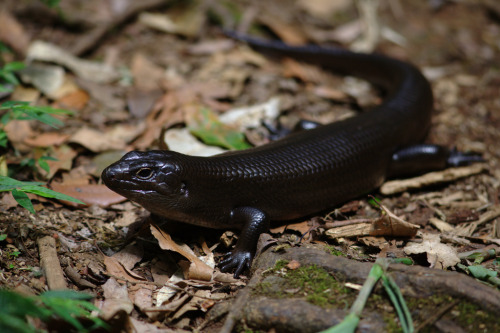Egernia major
Giant Stachelskink ( Bellatorias major), Lamington NP, Queensland ( Australia)
The Giant Stachelskink ( Bellatorias major, previously Egernia major) is a species of reptile from the family of skinks. He is one of the largest skinks in Australia and is called by the Australians land Mullet.
Features
The Giant Stachelskink reached a total length up to 65 cm, about half of which is attributable to his actual body length ( snout to anus). The tail length is the 1-1.2 times its actual body length. Head and body show an approximately square cross section. The back is dark brown to gray, the scales keeled smooth to weak. Unlike other types of Egernia Group, he has a small number (28-30) of rows of scales in its midsection. The Skink has relatively large eyes, the lids are surrounded by a distinct cream- colored ring. Males and females differ little: adult males have a slightly shorter body and a slightly longer head. From his next of kin Bellatorias frerei it differs by the scales on the 4th Toe: The Giant Stachelskink has two rows of scales frerei on the 4th toe as opposed to a shed row at B..
Way of life
The Giant Stachelskink is diurnal, shy and lives on the ground. He prefers the edge of the rain forest, where he finds the one hand, fallen trees as protection and on the other hand can sunbathe on glades. Like a number of other types of Egernia Group, he shows a pronounced social behavior and lives in family groups. He is an omnivore: mainly fungi, but also berries, seeds, insects and snails are some of his food. Mating takes place in October, 2-9 live young are born in February then. At birth, the pups have a total body length of about 15 cm. Giant Stachelskinks reach old age ( 11-23 years). To their enemies among the red-bellied black otter.
Dissemination
The Giant Stachelskink lives in the rainforests of eastern Queensland and New South Wales (Australia ) between the Conondale Ranges in the north and the Hawkesbury River in the south. It occurs from sea level to about 840 m.
System
The Giant Stachelskink was first described in 1845 by the curator John Edward Gray of the Zoological Department of the British Museum as Tropidolepisma major. In February 1845 there appeared a figure in the British Antarctic Expedition 1839-1843 report, then in June of the same year, a description of a specimen from the collection of the British Museum. 1887 this species was assigned to the genus by Boulenger Egernia. Therefore, the giant Stachelskink in the literature is usually referred to as Egernia major. However, it was in the 19th century believed that hide different genera under the name Egernia. But only in 2008 could Gardner et al. by molecular studies to clarify the phylogeny of Egernia group. They split this group into four genera and arranged the Riesenskink the genus Bellatorias ( Wells & Wellington, 1984) to.










